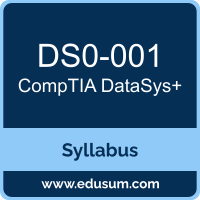 Use this quick start guide to collect all the information about CompTIA DataSys+ (DS0-001) Certification exam. This study guide provides a list of objectives and resources that will help you prepare for items on the DS0-001 CompTIA DataSys+ exam. The Sample Questions will help you identify the type and difficulty level of the questions and the Practice Exams will make you familiar with the format and environment of an exam. You should refer this guide carefully before attempting your actual CompTIA DataSys Plus certification exam.
Use this quick start guide to collect all the information about CompTIA DataSys+ (DS0-001) Certification exam. This study guide provides a list of objectives and resources that will help you prepare for items on the DS0-001 CompTIA DataSys+ exam. The Sample Questions will help you identify the type and difficulty level of the questions and the Practice Exams will make you familiar with the format and environment of an exam. You should refer this guide carefully before attempting your actual CompTIA DataSys Plus certification exam.
The CompTIA DataSys+ certification is mainly targeted to those candidates who want to build their career in Data domain. The CompTIA DataSys+ exam verifies that the candidate possesses the fundamental knowledge and proven skills in the area of CompTIA DataSys Plus.
CompTIA DataSys+ Exam Summary:
| Exam Name | CompTIA DataSys+ |
| Exam Code | DS0-001 |
| Exam Price | $273 (USD) |
| Duration | 90 mins |
| Number of Questions | 90 |
| Passing Score | 700 (on a scale of 100–900) |
| Books / Training | CompTIA CertMaster Learn |
| Schedule Exam | Pearson VUE |
| Sample Questions | CompTIA DataSys+ Sample Questions |
| Practice Exam | CompTIA DS0-001 Certification Practice Exam |
CompTIA DS0-001 Exam Syllabus Topics:
| Topic | Details |
|---|---|
Database Fundamentals - 24% |
|
| Compare and contrast database structure types. |
- Relational vs. non-relational databases - Linear vs. non-linear format - NoSQL types
- Tools
|
| Given a scenario, develop, modify, and run SQL code. |
- Data definition language (DDL) - Data manipulation language (DML) - Set-based logic - Transaction control languages (TCLs) - Atomicity, consistency, isolation, durability (ACID) principles - American National Standards Institute (ANSI) Structured Query Language (SQL) - Programming with SQL
|
| Compare and contrast scripting methods and scripting environments. |
- Script purpose and runtime location
- Languages
- Command-line scripting
|
| Explain the impact of programming on database operations. |
- Object-relational mapping (ORM)
- Process to gauge impact
|
Database Deployment - 16% |
|
| Compare and contrast aspects of database planning and design. |
- Requirements gathering
- Database architecture factors
- Design documentation
|
| Explain database implementation, testing, and deployment phases. |
- Acquisition of assets - Phases of deployment
- Database connectivity
- Testing
- Validate
|
Database Management and Maintenance - 25% |
|
| Explain the purpose of monitoring and reporting for database management and performance. |
- System alerts/notifications
- Transaction log files
|
| Explain common database maintenance processes. |
- Query optimization - Index optimization - Patch management
- Database integrity checks
- Data corruption checks
- Load balancing
|
| Given a scenario, produce documentation and use relevant tools. |
- Data dictionaries - Entity relationship diagram (ERD) - Maintenance documentation - Standard operating procedure (SOP) documentation
- Tools
|
| Given a scenario, implement data management tasks. |
- Data management
- Data redundancy |
Data and Database Security - 23% |
|
| Explain data security concepts. |
- Encryption
- Data masking
- Data destruction techniques
- Code auditing
|
| Explain the purpose of governance and regulatory compliance. |
- Data loss prevention - Data retention policies - Data classification
- Global regulations
- Regional regulations |
| Given a scenario, implement policies and best practices related to authentication and authorization. |
- Access controls
- Password policies |
| Explain the purpose of database infrastructure security. |
- Physical
- Logical
|
| Describe types of attacks and their effects on data systems. |
- SQL injection - Denial of service (DoS) attacks - On-path attacks - Brute-force attacks - Phishing - Malware
|
Business Continuity - 12% |
|
| Explain the importance of disaster recovery and relevant techniques. |
- Disaster recovery (DR) planning
- DR plan testing
- Transition/failback to normal operations |
| Explain backup and restore best practices and processes. |
- Full backup vs. incremental
- Database dumping
- Retention policy
|
To ensure success in CompTIA DataSys Plus certification exam, we recommend authorized training course, practice test and hands-on experience to prepare for CompTIA DataSys+ (DS0-001) exam.
